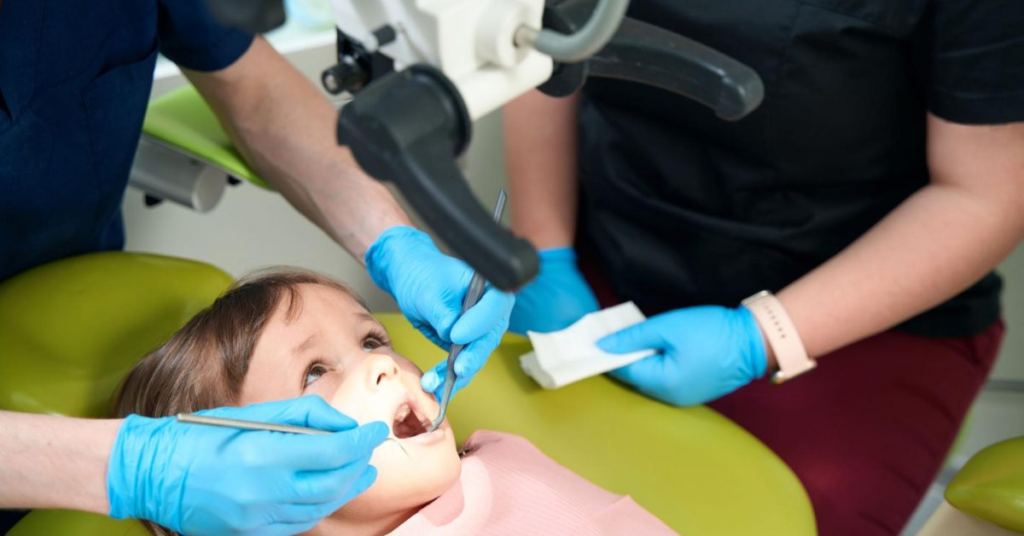
As a parent, one of the scariest things you can experience is seeing your child experience dental trauma. Whether it’s from a fall, sports injury, or other accident, dental trauma can cause a lot of pain and anxiety for both the child and the parent. That’s why it’s important to know how dentists can help manage pediatric dental trauma during your appointment.
Pediatric dental trauma can range from minor chips and cracks to more severe injuries such as loss of a tooth or fractured jaws. The first step in managing dental trauma is to assess the severity of the injury. If there is any damage to the tooth structure, loss of teeth, or unexplained pain, it’s important to contact your dentist right away.
Whether it is a dental emergency appointment or a dental trauma follow-up visit, your dentist can help you determine the severity of the injury and provide appropriate treatment.
Children can be rough and rowdy, oftentimes taking risks that adults otherwise wouldn’t. Got a new skateboard for their birthday? Learning to ride a bike or play on the local park’s equipment or play a full-contact sport? Dental trauma can follow in a blink of an eye.
One of the most common types of dental trauma in children is a knocked-out tooth. If your child has a knocked-out tooth, it’s important to act quickly. Don’t panic!
With a knocked-out tooth, there is both good and bad news. The good news is, if you act quickly enough, there may be a chance to reinsert the tooth back into the socket. The first thing you should do is locate the tooth if it can be found. If the tooth is dirty, you can rinse it with milk or water, but avoid touching the root. Once you’ve located the tooth, try to reinsert it into the socket if possible. If you’re not able to reinsert the tooth, place it in a container of milk or saliva and bring it with you to the dentist.
Unfortunately, the bad news is that there is only a small chance that the tooth may survive long-term after reinsertion, and only if this is done within the first 5 minutes after the injury.
If a knocked-out tooth is not reinserted within five minutes, likely, the tooth root will not reattach properly to the periodontal ligament, which holds the tooth in place. Instead, the root may fuse directly with the bone, causing ankylosis. This can lead to resorption and eventual loss of the tooth.
The resorption process varies from person to person but typically takes four to seven years if the tooth receives a root canal treatment to remove dead tissue and prevent infection. However, the tooth may darken and appear uneven in the smile line due to its fusion with the jawbone. It may be best to replace the tooth with an implant or other cosmetic solution for a more aesthetic appearance. Quick action in reinserting the tooth is crucial for its survival.
If your child has a chipped or cracked tooth, your dentist may recommend a dental crown or filling. The type of treatment will depend on the severity of the injury and the location of the tooth. A root canal may be necessary to save the tooth in some cases.
Another common type of dental trauma in children is a fractured jaw. If you suspect your child’s jaw has been fractured, it is important to seek immediate medical attention. Calling your family dentist is the right first step to take. Your dentist may recommend immobilizing the jaw with a splint or wiring the jaw shut to promote healing.
In addition to providing treatment for dental trauma, dentists can also help prevent future injuries. If your child participates in sports, your dentist may recommend a custom mouthguard to protect their teeth during physical activity. Mouthguards can help prevent chipped, cracked, or knocked-out teeth, as well as other types of dental trauma.
Things parents can do to help prevent oral trauma:
- Baby Proof like there is no tomorrow! Baby Proofing such as safety gates, safety locks, and latches, covering sharp corners, and keeping an eye on children while they’re on changing tables or high chairs can help prevent oral trauma.
- Use protective gear during sports and while riding bikes and skateboards. Mouth guards and helmets not only protect your child’s head but can also help prevent dental trauma too!
- Teach your children not to run or walk with items in their mouths. A pen or popsicle can become a problem if a child trips and falls!
- Avoiding hard candies that can damage the tooth.
Tips for Dentists treating pediatric oral trauma:
- Billing medical insurance can relieve the financial burden on families faced with treating dental trauma.
- Provide guidance on wearing appropriate mouth guards while playing sports.
- Providing a list of foods that should be avoided due to the risk of injury.
Remember, while the treatment of dental treatment can be stressful both emotionally and financially, the expansion of billing medical insurance for dental treatments for accidents can help to save parents on the treatments their child needs.
Overall, dental trauma can be a scary and stressful experience for both children and parents. However, with prompt treatment and preventative measures, dentists can help manage pediatric dental trauma and ensure that your child’s smile remains healthy and beautiful. If you suspect your child has experienced dental trauma, don’t hesitate to contact your dentist right away. They can help you determine the best course of action and provide the necessary treatment to promote healing and prevent future injuries.

Danielle Duncan